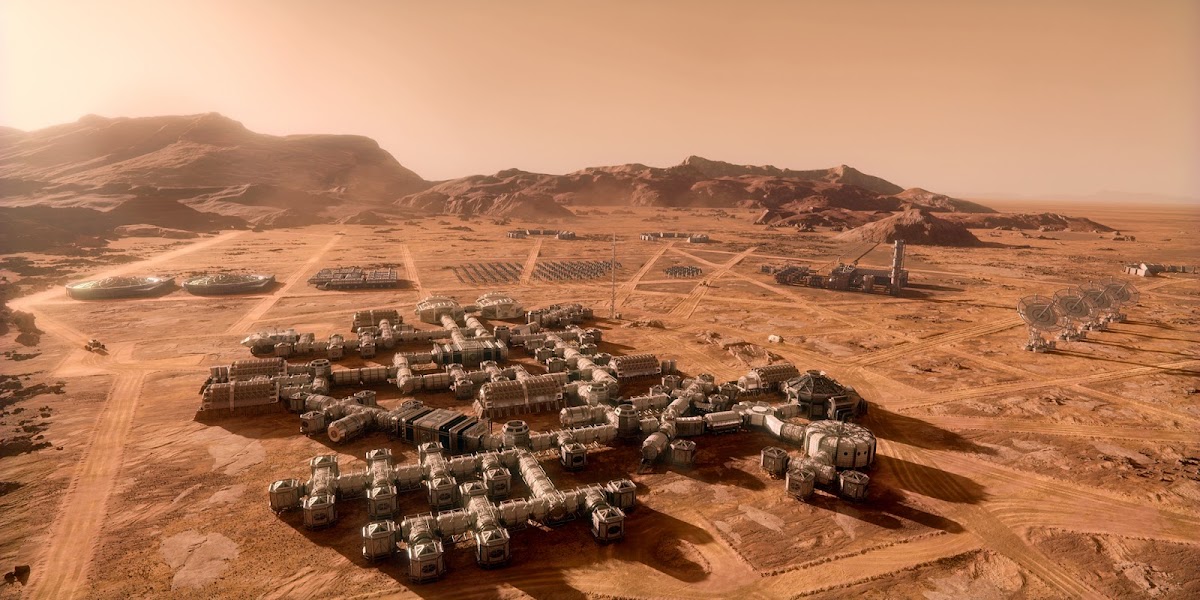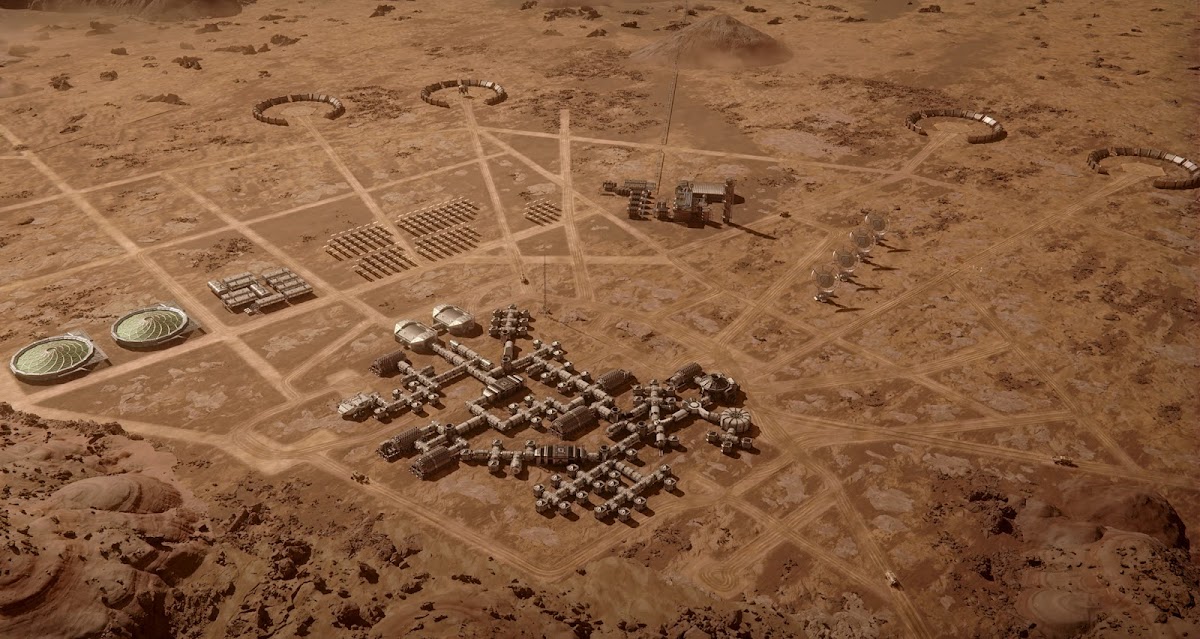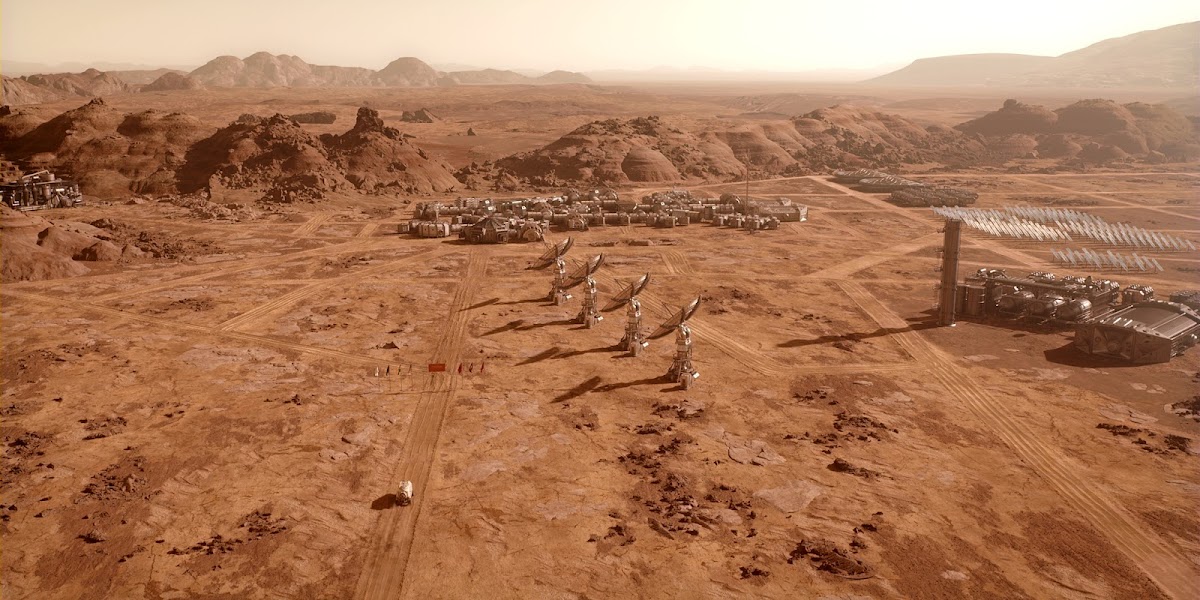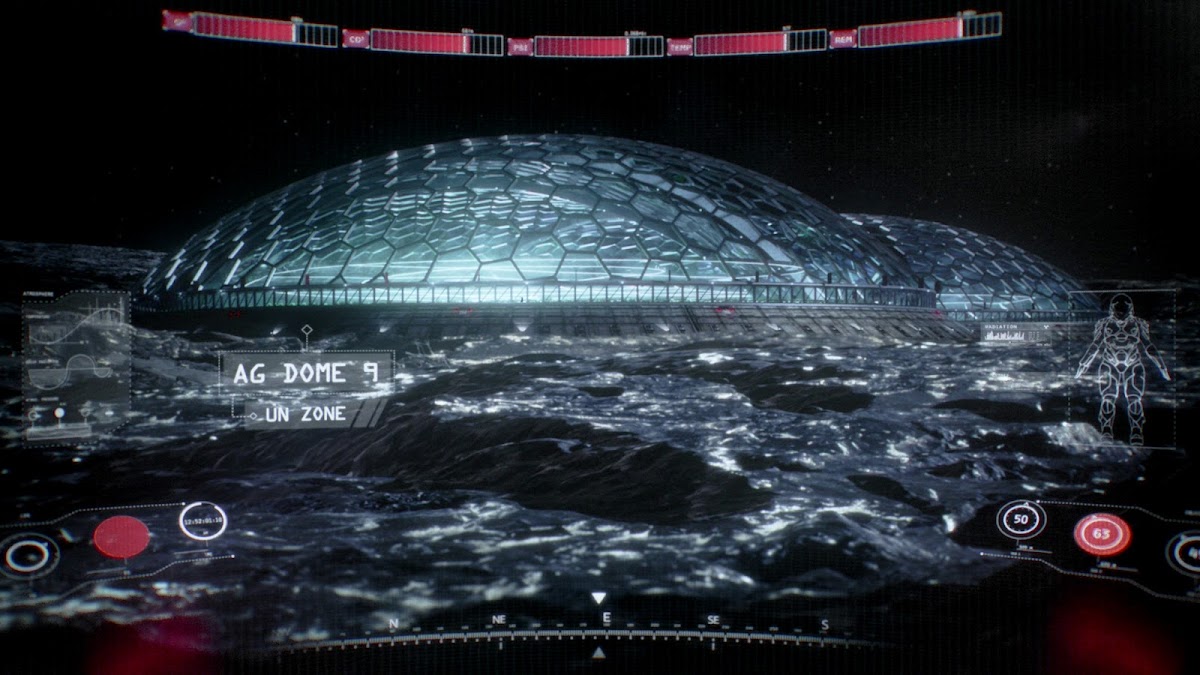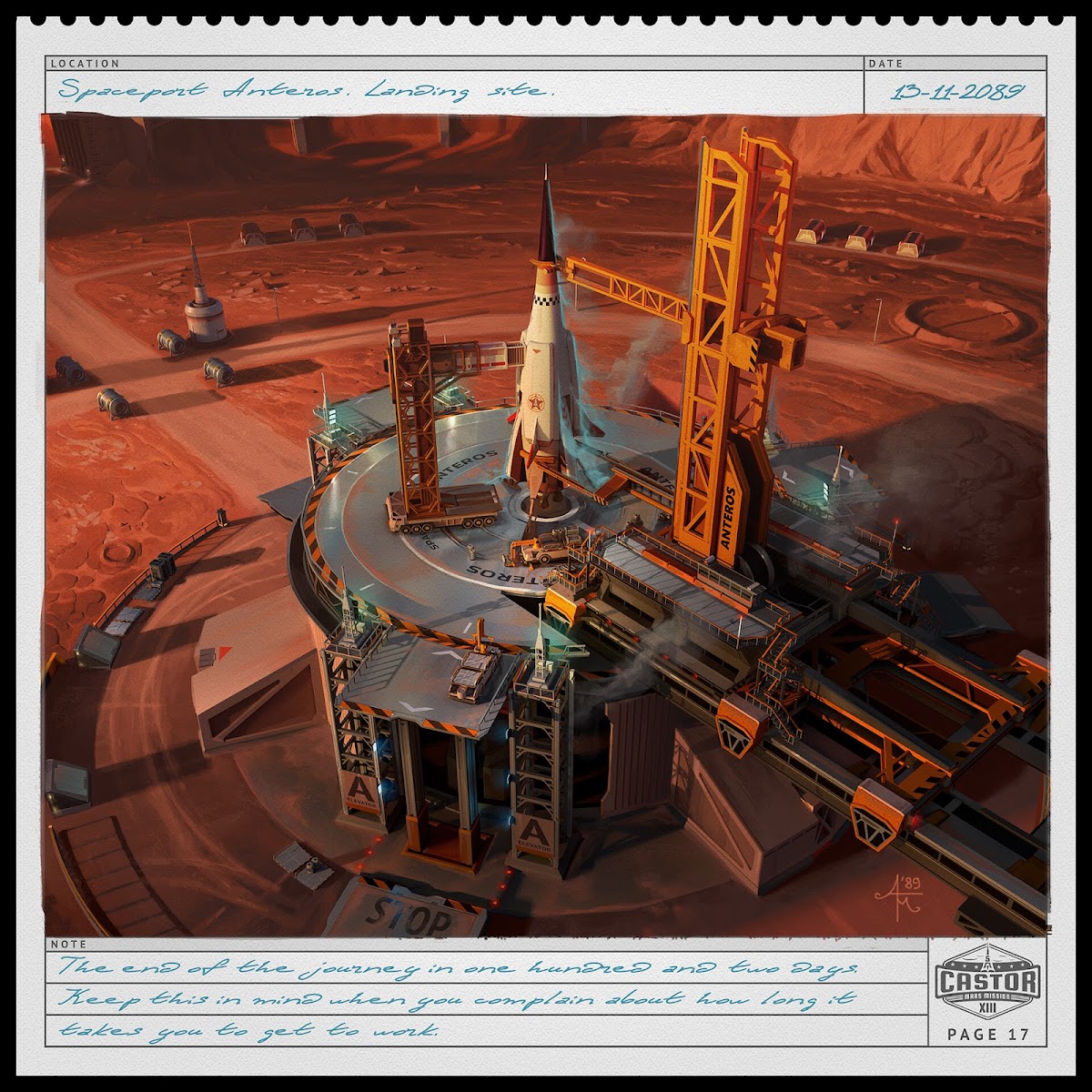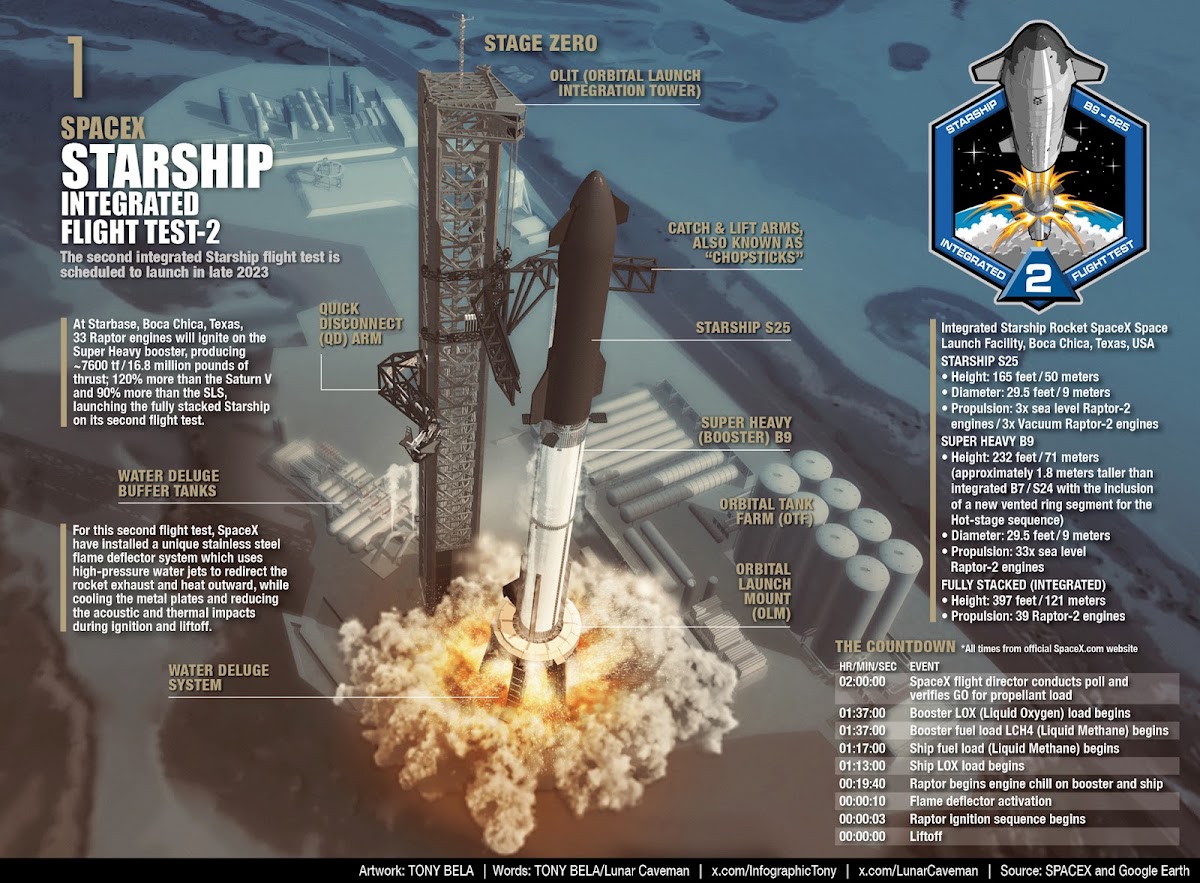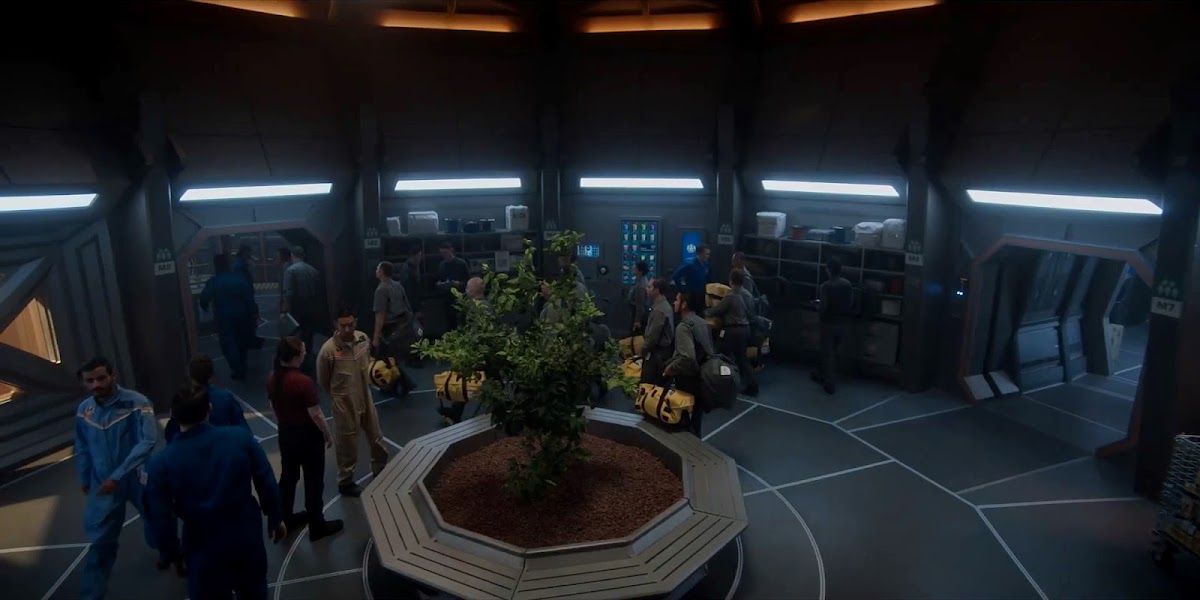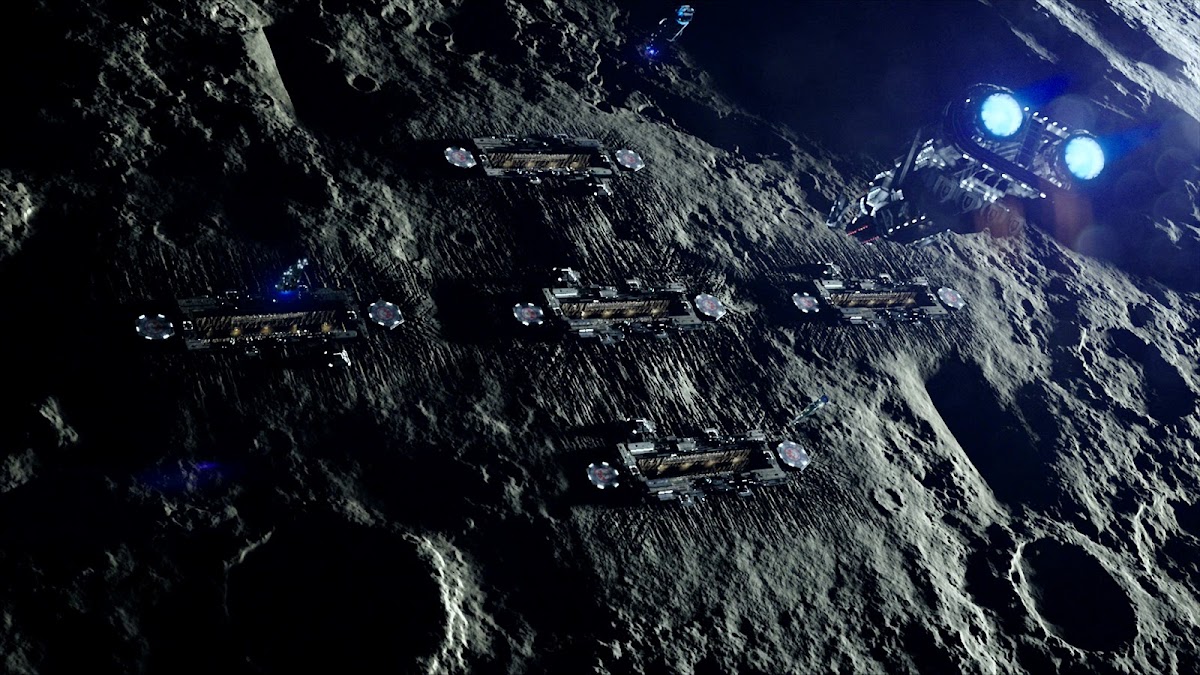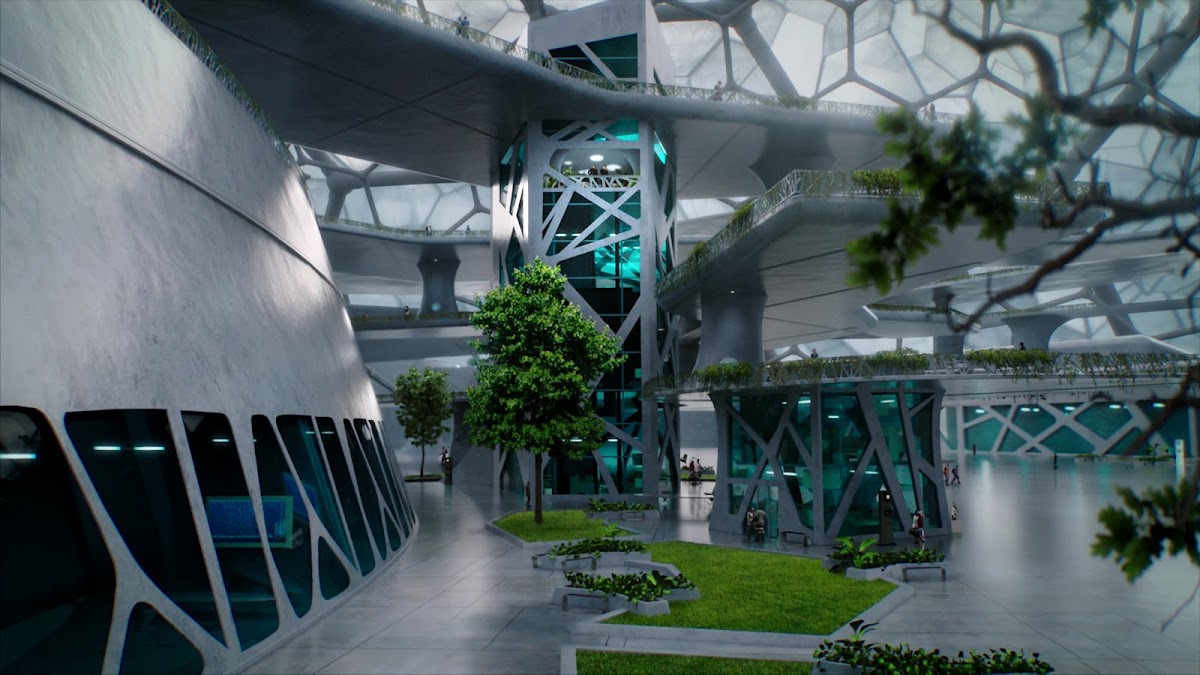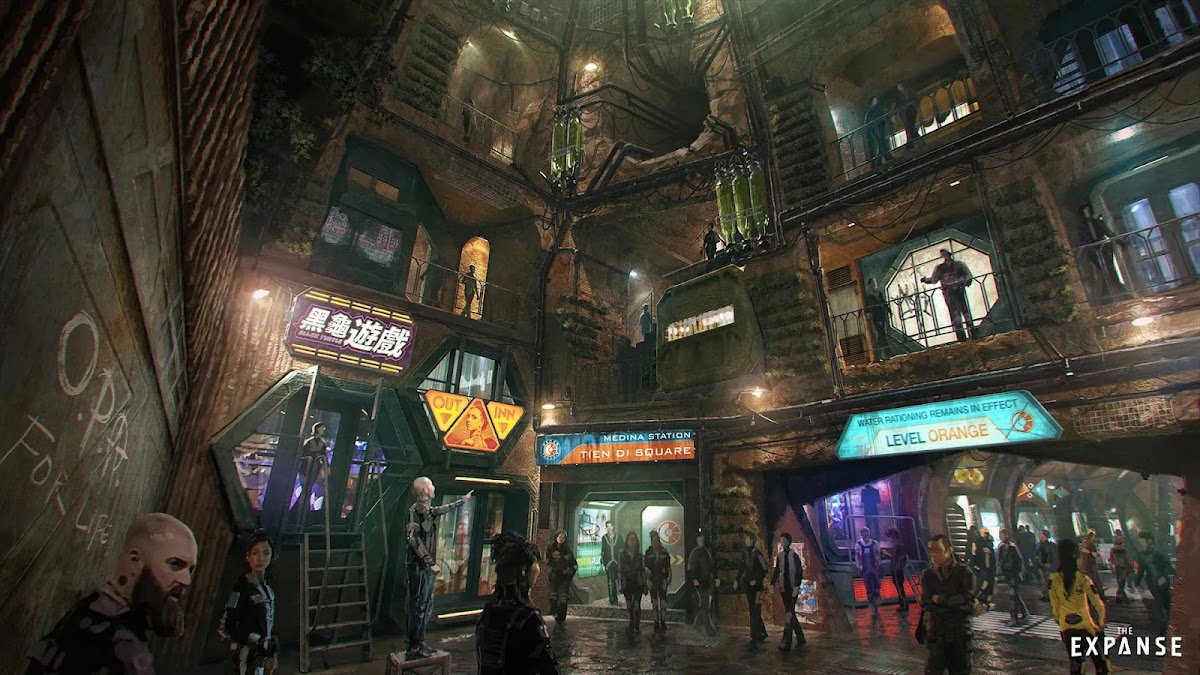Season 4 of For All Mankind alternate history sci-fi TV series, depicting alternate 2003, "is really about the building of a new civilization on Mars" by the words of the co-creator of the series Ben Nedivi. The international Happy Valley Base, founded in 1995 during season 3 and located in Melas Chasma in the Valles Marineris canyon system on Mars, has been significantly expanded and there are around 200 people living in the base during season 4. The base is financed and operated by Mars-7 Alliance (consisting of US, USSR, ESA, North Korea, India, Japan, and the Coalition of Communist Countries for Spaceflight (CCCS)) and maintained by a private company Helios Aerospace.
Ground level of the base features several separate facilities for power generation, communications, fuel refinement, regolith processing, algae production, storage etc. and a central interconnected cluster of modules consisting of the Entrance hall for new arrivals with airlocks for the rovers, control rooms, laboratories, hydroponic farms, meeting rooms, warehouses / garages, a cafeteria, as well as the quarters for higher level personnel and astronauts / cosmonauts. The base has 5 underground sublevels, of which level 4 & 5 are still under construction in 2003 and not accessible. The sublevels house maintenance and storage rooms and additional quarters for workers. There is also a separate North Korean sector accessible only to North Koreans. The base also operates six landing pads for their orbital Hopper shuttles.
The design of the Happy Valley Base in For All Mankind is the most plausible design of a mid-sized human base on Mars that we have ever seen in a TV series or film.
For All Mankind is exploring the idea of never ending space race if Soviets would have beaten US in the race for the Moon and the intention of the show is each season to jump about a decade further into the increasingly diverging reality of the show: in season 1, depicting alternate 1969 to 1974, both Soviets and US start building their separate bases near the lunar South pole; in season 2 (1983) both bases have been expanded and the superpowers compete for resources on the Lunar surface; in season 3 (1992 to 1995), Soviets and US are joined by a private company Helios and North Korea for a four way race to be first on Mars; in season 4 (2003) there is a sprawling international human base on Mars and an unexpected side enters the race to get hold on a large, lithium-rich asteroid for mining.
Here we collected high resolution shots from season 4 (downscaled from 4K UHD screens for better image quality) depicting the exterior and interior of Happy Valley Base on Mars. No images revealing major story plots are included. We will make a separate article with season 4 story spoilers after the last episode will be released on January 12. [UPDATED:]
How to steal an asteroid .. "For All Mankind" season 4
Wednesday, January 10, 2024
Wednesday, December 13, 2023
Ganymede, the breadbasket of the Belt, in "The Expanse" TV series
Ganymede is one of the "Galilean moons" of Jupiter and the largest moon in the Solar System. It's only slightly smaller than Mars, but with only half the density, its gravity is actually weaker than the Moon's. Ganymede is the only moon with any magnetosphere thus having the ability to deflect charged ionizing radiation. In the universe of The Expanse TV series (a political sci-fi drama set in mid-24th century when humans have colonized the entire Solar system) Ganymede acts as the breadbasket of the Belt - one of the three competing powers in The Expanse, along with the United Nations (based on Earth) and Mars.
In the universe of The Expanse Ganymede has millions of residents and Ganymede Station was one of the first permanent human settlements in the outer planets, built as a long term colony with large domes filled with food crops. Large mirrors were placed around the moon to supply the Sun's light to the surface for crop growth. It was known as the safest station in the Jovian system, and many humans from other colonies traveled to Ganymede to deliver their babies, as the magnetosphere helps claim the Jovian moon the lowest amount of birth defects and stillbirths. Initially, at the start of the series, Ganymede is divided between the United Nations and Mars.
The life on Ganymede is depicted in season 2 of The Expanse. Here you can view some of the best shots from Ganymede (downscaled from 4K UHD screens for better image quality) as well as some concept art for it.
In the universe of The Expanse Ganymede has millions of residents and Ganymede Station was one of the first permanent human settlements in the outer planets, built as a long term colony with large domes filled with food crops. Large mirrors were placed around the moon to supply the Sun's light to the surface for crop growth. It was known as the safest station in the Jovian system, and many humans from other colonies traveled to Ganymede to deliver their babies, as the magnetosphere helps claim the Jovian moon the lowest amount of birth defects and stillbirths. Initially, at the start of the series, Ganymede is divided between the United Nations and Mars.
The life on Ganymede is depicted in season 2 of The Expanse. Here you can view some of the best shots from Ganymede (downscaled from 4K UHD screens for better image quality) as well as some concept art for it.
Inside an agricultural dome on Ganymede:
Magnetosphere protects Ganymede from Jupiter's harsh radiation belt:
A ship landing at a human colony on Ganymede:
Concept art for a Ganymede greenhouse by Romain Jouandeau:
Thursday, November 30, 2023
Tesla Cybertruck - a pickup truck made for Mars
4 years after the initial unveiling, today is the day when the long-anticipated Tesla Cybertrucks will be delivered to the first customers. Cybertruck is an electric pickup truck with a radically different design and features that no other automaker has ever attempted. Tesla's stainless steel pickup truck doesn't even look like it's made for Earth. Indeed, on several occasions, Elon Musk has stated that a "pressurized edition" of Cybertruck will be the "official truck of Mars".
Of course, the Cybertruck will need to be heavily modified to be useful in Martian conditions (the pressure difference is just one of the problems that will need to be solved), but we can easily imagine a truck with Cybertruck's design features driving around on Mars in not so distant future. We can even imagine a Tesla factory producing those Martian Cybertrucks on Mars itself as early as the 2050s.
Cybertruck Delivery Event will be livestreamed on Tesla's website at 2:00 pm CT.
 |
| Illustration of Tesla Cybertruck on Mars by Canadian graphic designer Andres Gonzalez |
Of course, the Cybertruck will need to be heavily modified to be useful in Martian conditions (the pressure difference is just one of the problems that will need to be solved), but we can easily imagine a truck with Cybertruck's design features driving around on Mars in not so distant future. We can even imagine a Tesla factory producing those Martian Cybertrucks on Mars itself as early as the 2050s.
Cybertruck Delivery Event will be livestreamed on Tesla's website at 2:00 pm CT.
Friday, November 24, 2023
Spaceport on Mars - Part 3 of Martian sketches by Andrey Maximov
 Environment concept artist Andrey Maximov from Armenia has created an impressive set of artworks called Martian sketches depicting a "routine" journey to Mars in 2089. So far he has published 25 pages of those sketches. As the artist describes them: "this series is kind of like the road sketches of a member of an expedition to Mars. It's a routine flight in the not-too-distant future. The planet is more or less inhabited. We have an orbital station around Mars. There are already several settlements on the surface, mining is going on."
Environment concept artist Andrey Maximov from Armenia has created an impressive set of artworks called Martian sketches depicting a "routine" journey to Mars in 2089. So far he has published 25 pages of those sketches. As the artist describes them: "this series is kind of like the road sketches of a member of an expedition to Mars. It's a routine flight in the not-too-distant future. The planet is more or less inhabited. We have an orbital station around Mars. There are already several settlements on the surface, mining is going on."
1st part (10 sketches) of Andrey's Martian sketches depicted the expedition leaving Earth;
2nd part (5 sketches) depicted expedition's arrival to International Mars Orbital Station
Here is 3rd part (6 sketches) depicting spaceport "Anteros" on Mars:
Wednesday, November 15, 2023
SpaceX Starship orbital flight test 2 - infographic by Tony Bela (updated)
Australian space illustrator Tony Bela has created an infographic of the upcoming 2nd integrated flight test of SpaceX's Starship rocket (booster B09, ship S25) on Saturday, November 18 Friday, November 17 (a 20 minute launch window opens at 7:00 a.m. CT pending final regulatory approval) from Starbase, Boca Chica, Texas.
SpaceX: "Starship’s first flight test [on April 20] provided numerous lessons learned that directly contributed to several upgrades to both the vehicle and ground infrastructure to improve the probability of success on future flights. The second flight test will debut a hot-stage separation system and a new electronic Thrust Vector Control (TVC) system for Super Heavy Raptor engines, in addition to reinforcements to the pad foundation and a water-cooled steel flame deflector, among many other enhancements."
SpaceX: "Starship’s first flight test [on April 20] provided numerous lessons learned that directly contributed to several upgrades to both the vehicle and ground infrastructure to improve the probability of success on future flights. The second flight test will debut a hot-stage separation system and a new electronic Thrust Vector Control (TVC) system for Super Heavy Raptor engines, in addition to reinforcements to the pad foundation and a water-cooled steel flame deflector, among many other enhancements."
Breakdown of Tony's infographic into phases:
Wednesday, November 8, 2023
Building a new civilization on Mars in "For All Mankind" season 4
 Yesterday Apple TV+ released yet another video revealing more details about the upcoming season 4 of For All Mankind alternate history sci-fi TV series. As the co-creator of the series Ben Nedivi states in this featurette: "This season is really about the building of a new civilization on Mars. Last year in season 3 you saw the first explorers arrive on Mars. This season you're actually seeing hundreds of people up there and you're seeing, how civilization becomes civilization".
Yesterday Apple TV+ released yet another video revealing more details about the upcoming season 4 of For All Mankind alternate history sci-fi TV series. As the co-creator of the series Ben Nedivi states in this featurette: "This season is really about the building of a new civilization on Mars. Last year in season 3 you saw the first explorers arrive on Mars. This season you're actually seeing hundreds of people up there and you're seeing, how civilization becomes civilization".
Judging from the reviews by journalists who were given early access to the first 7 episodes of season 4, this season might be the show's most exciting season yet. We look forward to judging it for ourselves. Season 4 premieres November 10 on Apple TV+, with episodes releasing weekly.
Some of the details for season 4 were previously revealed in a teaser and a trailer.
For All Mankind is exploring the idea of never ending space race if Soviets would have beaten US in the race for the Moon and the intention of the show is each season to jump about a decade further into the increasingly diverging reality of the show: in season 1, depicting alternate 1969 to 1974, both Soviets and US start building their separate bases near the lunar South pole; in season 2 (1983) both bases have been expanded and the superpowers compete for resources on the Lunar surface; in season 3 (1992 to 1995), Soviets and US are joined by a private company Helios and North Korea for a four way race to establish the first human base on Mars.
Here are some HD images from the featurette above.
Happy Valley base on Mars:
Friday, November 3, 2023
Ceres, the capital of the Belt, in "The Expanse" TV series
Ceres, located in the Main Asteroid Belt between the orbits of Mars and Jupiter, is the largest known asteroid (~940km in diameter) and the only dwarf planet in the Inner Solar system. In the universe of The Expanse TV series (a political sci-fi drama set in mid-24th century when humans have colonized the entire Solar system) Ceres acts as the de facto capital for the Belt - one of the three competing powers in The Expanse, along with the United Nations (based on Earth) and Mars.
Ceres naturally has a gravity of 0.029g (2,9% of the gravity force on Earth), but in the universe of The Expanse it has been artificially spun up to 0.3g of centrifugal force (so the "gravity" points in the opposite direction, not towards the center of the planet). There is a population of around 6 million in Ceres Station which consists of tens of thousands of kilometers of tunnels bored deep into Ceres. Ceres Station is the most important spaceport in the Belt, 800 to 1'000 ships are docked on Ceres every day, so along with the 6 million permanent residents there are an extra one million transiting through at any given time. Ceres Station was initially governed by the United Nations, but during season 1 of the show Outer Planets Alliance (OPA, a fractured sociopolitical movement trying to unite the Belt) takes control.
The life on Ceres is depicted in season 1 and season 6 of The Expanse. Here you can view some of the best shots from locations on Ceres Station (part of them downscaled from 4K UHD screens for better image quality) as well as some concept art for Ceres:
Ceres naturally has a gravity of 0.029g (2,9% of the gravity force on Earth), but in the universe of The Expanse it has been artificially spun up to 0.3g of centrifugal force (so the "gravity" points in the opposite direction, not towards the center of the planet). There is a population of around 6 million in Ceres Station which consists of tens of thousands of kilometers of tunnels bored deep into Ceres. Ceres Station is the most important spaceport in the Belt, 800 to 1'000 ships are docked on Ceres every day, so along with the 6 million permanent residents there are an extra one million transiting through at any given time. Ceres Station was initially governed by the United Nations, but during season 1 of the show Outer Planets Alliance (OPA, a fractured sociopolitical movement trying to unite the Belt) takes control.
The life on Ceres is depicted in season 1 and season 6 of The Expanse. Here you can view some of the best shots from locations on Ceres Station (part of them downscaled from 4K UHD screens for better image quality) as well as some concept art for Ceres:
Mid-town Ceres Station:
Ceres Station docks on the surface of Ceres:
Administrative Plaza of Ceres:
Concept art for The Medina level on Ceres by North Front Studio:
Monday, October 23, 2023
International Mars Orbital Station - Part 2 of Martian sketches by Andrey Maximov
 Environment concept artist Andrey Maximov from Armenia has created an impressive set of artworks called Martian sketches depicting a "routine" journey to Mars in 2089. So far he has published 25 pages of those sketches. As the artist describes them: "this series is kind of like the road sketches of a member of an expedition to Mars. It's a routine flight in the not-too-distant future. The planet is more or less inhabited. We have an orbital station around Mars. There are already several settlements on the surface, mining is going on."
Environment concept artist Andrey Maximov from Armenia has created an impressive set of artworks called Martian sketches depicting a "routine" journey to Mars in 2089. So far he has published 25 pages of those sketches. As the artist describes them: "this series is kind of like the road sketches of a member of an expedition to Mars. It's a routine flight in the not-too-distant future. The planet is more or less inhabited. We have an orbital station around Mars. There are already several settlements on the surface, mining is going on."
1st part (10 sketches) of Andrey's Martian sketches depicted the expedition leaving Earth.
Here is 2nd part (5 sketches) depicting expedition's arrival to International Mars Orbital Station:
Friday, October 13, 2023
Asteroid mining will play a major role in "For All Mankind" season 4
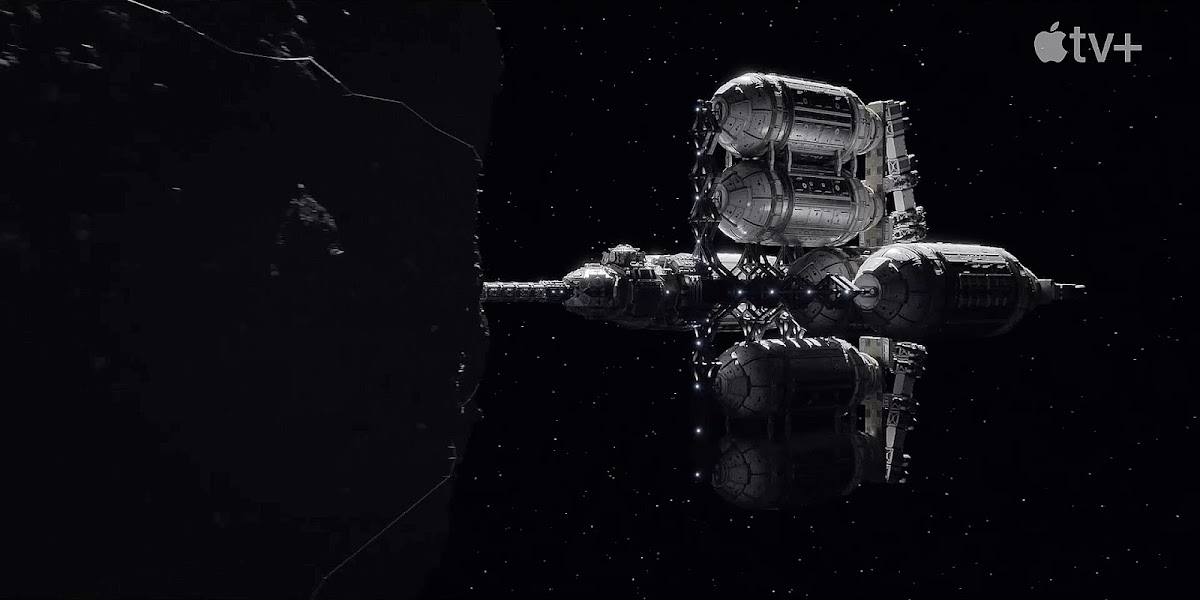 Yesterday Apple TV+ published a yet unlisted trailer for season 4 of For All Mankind alternate history sci-fi TV series, revealing asteroid mining will play a major role in season 4, set in 2003. The trailer also revealed more details about the soon-to-be "self-sustaining" international Happy Valley base on Mars, first depicted in the first teaser for season 4 a month ago.
Yesterday Apple TV+ published a yet unlisted trailer for season 4 of For All Mankind alternate history sci-fi TV series, revealing asteroid mining will play a major role in season 4, set in 2003. The trailer also revealed more details about the soon-to-be "self-sustaining" international Happy Valley base on Mars, first depicted in the first teaser for season 4 a month ago.
For All Mankind is exploring the idea of never ending space race if Soviets would have beaten US in the race for the Moon and the intention of the show is each season to jump about a decade further into the increasingly diverging reality of the show: in season 1, depicting alternate 1969 to 1974, both Soviets and US start building their separate bases near the lunar South pole; in season 2 (1983) both bases have been expanded and the superpowers compete for resources on the Lunar surface; in season 3 (1992 to 1995), Soviets and US are joined by a private company Helios and North Korea for a four way race to establish the first human base on Mars. Season 4 will start airing on November 10 on Apple TV+ and will depict the alternate 2003.
Here you can watch the trailer and see some HD images from it:
Happy Valley base on Mars:
Sunday, October 8, 2023
Colonized Mars - Martian city lights from space
How would a colonized Mars appear from space? Here is a FHD wallpaper with lights of two large cities on Mars as they would be seen from space; created by an uncredited artist for the Mars City Design platform:
Subscribe to:
Posts (Atom)

